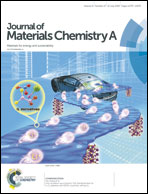Multi-cation crosslinked anion exchange membranes from microporous Tröger's base copolymers†
Abstract
Polymers of intrinsic microporosity (PIMs) represent a novel class of membrane materials attracting much attention over the past decade. But challenges still exist in the preparation of anion exchange membranes (AEMs) due to their poor solubility and brittleness. Here we present a new strategy to synthesize soluble PIMs for high performance AEMs. By combining merits of two Tröger's base units, the synthesized copolymer exhibits good solubility as well as excellent mechanical properties. The copolymer has good solubility in dimethylsulfoxide (DMSO) after little quaternization and thus permits crosslinking with a long-flexible multi-cation agent. The resulting membrane has good dimensional stability (20.8% swelling ratio at 60 °C) and excellent alkaline resistance. Subsequently, this membrane exhibits a high hydroxide conductivity of 103.9 mS cm−1 (80 °C) at a low ion exchange capacity (IEC) of 1.67 meq g−1. Moreover, this membrane achieves a peak power density of 158 mW cm−2 in a single fuel cell at a current density of 330 mA cm−2 at 60 °C. The presented approach is beneficial for developing high performance PIM-based AEMs and highlights the tremendous potential of multi-cation cross-linked Tröger's base AEMs for wide application in energy and separation fields.



 Please wait while we load your content...
Please wait while we load your content...